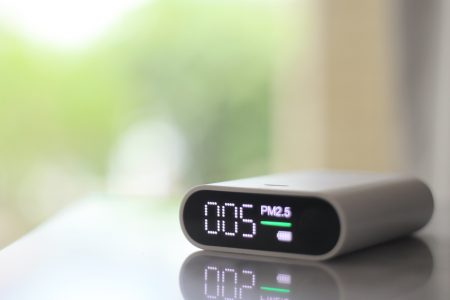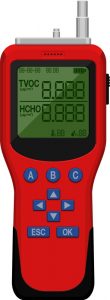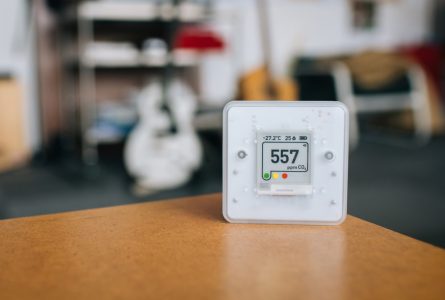Contaminants in your indoor air do not just come from pollution outside in fact, there are many ways in which indoor air can be even more polluted than outdoors. Mold, industrial chemicals, carbon dioxide and several other pollutants can build up in closed spaces lacking ventilation, and almost all of them are invisible to the naked eye.
Fortunately, there are a few things you can do to determine if your air is dirty and to improve it. The first step is to find out if the pollutants are coming from indoors or outdoors, after which you can try removing, blocking or redirecting the source. Sources of indoor pollution are typically small things like cooking, which can quickly make the air quality worse because the air is trapped behind walls and windows. On the other hand, larger outdoor sources of air pollution like busy roadways can cause poor air quality for longer periods of time as the dirty air seeps in from outside slowly but constantly.
If you have allergies, asthma or any other respiratory concerns, or if you live with someone very old or very young, or are even just curious, you can learn how to measure your air quality at home. Here is how:

#1 - Use a particulate sensor
Particulate matter refers to any solid or liquid particle small enough to remain suspended in the air, and is the most prevalent form of air pollution. It is typically measured in at least two sizes: larger PM10 and the smaller PM2.5. PM10, or coarse particulate matter, can come from mining operations, brake pads, construction operations, agriculture or wind erosion. PM2.5, or fine particulate matter, is primarily emitted through the combustion of organic fuel in vehicles, power plants, and wildfires or from chemical pollutants aggregating in the atmosphere. They are both unhealthy, but PM2.5 can penetrate further into the lungs and potentially do more damage.
Detecting indoor particle pollution
A particle sensor that detects PM2.5 is the easiest way to know if there is particle pollution present. They cost around $100 and are available at hardware stores and online. Many of these will translate indoor air quality into something similar to the color-coded EPA Air Quality Index that goes from good to bad as it cycles through green, yellow, orange, red and purple colors. However, the EPA uses expensive equipment operated by skilled technicians, so you should not expect a sensor that costs around a hundred dollars to have as accurate of a reading.
Although they are not accurate enough for scientific research, consumer particle sensors can provide enough of an estimate of the indoor air quality to know if a source of particle pollution is present. If a particle sensor reports the air quality is bad, then you should do something about it.
Determine the source and reduce pollutants
To determine the source of your indoor air pollution, compare your particle sensor reading with the local EPA air quality station and see if the outside air is better. If so, the source is indoors. Because of the discrepancies between sensors and how each one detects particles and reports colors, only assume large differences in color code are significant. For example, purple indoors and green outside is very likely an indoor source, while orange indoors and yellow outdoors is more ambiguous.
Outdoor sources can be mitigated with better weather stripping and indoor filtration using a portable air purifier. In extreme outdoor air quality events like wildfire, it is best to keep the air in one room as clean as possible €” ideally the bedroom where you sleep. If better weather stripping is not feasible, any method to seal cracks around windows and doors, such as painter's tape, could be used in emergencies to keep the smoke out.
Indoor sources of particle pollution can be tracked by noting what time of day the reading goes up. Likely sources include cooking, vacuuming and candles. Humidifiers may also increase the number of particles detected, but aerosolized water is harmless and not considered particle pollution. Indoor sources of particle pollution are best dealt with through ventilation by opening windows or turning on the fan above cooking. Portable air purifiers can also be used to remove particles near the source.

#2 - Use a Volatile Organic Compound (VOC) detector
These devices detect specific types of chemical pollutants in the air called volatile organic compounds, or VOCs. This type of pollutant can off-gas from new building materials, paint, adhesives and even new clothing. There are thousands of different VOCs, and some of them are very toxic while others are totally harmless. Unfortunately, the only way to identify individual VOCs for certain is to use laboratory equipment like gas chromatography and mass spectroscopy that can be calibrated with known quantities of VOCs. However, consumer detectors can still provide useful readings of indoor air quality.VOC Detection
Most VOC detectors will detect either or both the specific chemical formaldehyde (HCHO) or the total volatile organic compounds (TVOC) present. Formaldehyde is a common byproduct of modern industrial manufacturing and a carcinogenic household pollutant, so its detection is a good way to know if there is contamination.
TVOC readings are a little trickier, however, because this measurement represents the total amount of VOCs in the air. It will detect paint fumes, cleaning chemicals and other substances that could cause respiratory diseases. However, some VOCs in the air are not harmful, particularly in short or low doses. Essential oils and alcoholic beverages release large amounts of VOCs (you can tell by their potent smells) but are generally not considered contaminants. Given that many TVOC devices are calibrated to respond well to ethanol (the alcohol in intoxicating drinks) false readings can happen when a bottle of wine or similar beverage is opened nearby.
High levels of VOCs in the home can lead to allergic reactions and trigger asthma, and when combined with other pollutants can form particulate matter. Safe TVOC levels are below 1,000 micrograms per cubic meter (ug/m3), while readings over 3,000 are of particular concern.
How to reduce VOCs at their source
Because there are so many different types of VOCs, their sources can vary considerably. But for the most part VOCs are most likely to be emitted from new products. If you are seeing high levels of VOCs, you might want to look at any new furniture or building materials. Also consider any cleaning or industrial chemicals that might be stored near the house.
The best way to deal with VOCs is by ventilation. Air purifiers can also help. Heavy carbon or charcoal filters (measured in pounds) absorb VOCs for later disposal, and technology like PECO can destroy them. However, HVAC filtration systems with only dust filters will not have a meaningful impact.

#3 - Find mold
Mold is one of the few air pollutants that has an obvious physical form €” the black mold colony. Spores are constantly emitted from colonies and breathing them can cause allergies, trigger asthma, and other more serious health problems.
Mold needs liquid water and food to grow. It usually prefers soft wood, but can grow on almost any biological matter.
Mold detection
One way to test for mold is to leave the space for a while, then return and sniff to check for its scent. If you smell mold or otherwise think there may be mold, then the next step is to look for the colonies, which are dark patches that may resemble dirt. Look for places where the air may be still so spores can settle, such as corners and under installed features. Mold needs plenty of water, so also check anywhere water could be, such as under sinks, anywhere in a bathroom that has a shower or tub, under potted plants and on the surface of plant soil. If you still smell mold but are unable to find any, contact a professional to use a camera to look inside the walls and other hard-to-reach places.
If you find a potential colony, make sure it is not merely dirt by diluting bleach 1:16 with water and applying it to the dark patch with a swab. Mold will bleach and become clear, then typically grow back over a few days. Dirt will remain dark.
Killing mold at the source
The first step to ridding your indoor space of mold is to cut off the mold's source of water. Be sure any leaky pipes are fixed and that bathrooms are properly ventilated. Consider getting a humidity detector, if it reads higher than 75% a dehumidifier can help to reduce mold growth.
Use diluted bleach to kill it where it has infested. If it returns, mold may have penetrated building materials and even weakened them. In this case it is necessary to hire a professional mold remediator to replace the affected parts of the building.
Mold on the surface of indoor plant soil can be scraped off and disposed of outside, just be sure to remove all of it or spores will continue to spread. Then be sure the surface of the soil dries completely between each watering so any new spores that drift in do not have a chance to sprout.

#4 - Check for dust
Dust makes you sneeze because it harbors massive amounts of dust mites, which are tiny creatures that live on shed skin and moisture in the air. Exposure to dust mites can trigger asthma and allergies, and progress someone along what is called the atopic march which refers to how asthma, allergies, and eczema occur together and exacerbate each other.
In addition to mites, dust can harbor many other allergy-causing irritants like pollen, mold spores, pet dander, and even adsorbed VOCs. Bacteria may also live in dust, which can possibly cause an infection. Dust becomes an air quality problem when it gets kicked up by human activity. The particles settle to the ground within a few minutes, but that's enough time to get inhaled.
Detecting dust
Unfortunately, bacteria, dust mites, mold, pollen, and other allergens are in practically all indoor spaces to some degree. Like mold, dust is best detected with the eyes. If there is a gray, black, or brown layer of grit building up behind furniture and on windowsills, dust may be contributing to poor air quality.
Getting rid of dust at the source
Both dust mites and mold can be reduced by keeping the humidity below 50%, while pollen and other allergy-causing particles from outdoors can be reduced by taking off shoes and outer clothing when entering.
Physically removing the dust that builds up on surfaces by using warm soap and water on non-porous surfaces and vacuuming everything else is another key step. Vacuuming carpet and upholstery is vital because the dust that can accumulate among the fibers is easily stirred by foot traffic and other activity. If your dust allergies persist it might even be best to remove carpet completely and find mostly leather or wood furniture.
Finally, keep in mind that dust will also be close to your face if it has settled on your bedding, so do not neglect to clean your sheets and pillowcases. If allergies are persistent when waking up, it might be necessary to get anti-dust mite bedding that has few cracks and crevices for them to live.

#5 - Use a carbon dioxide detector
Carbon dioxide (CO2) is exhaled by humans as a byproduct of our metabolism. As it builds up it starts to displace oxygen and cause problems at the cellular level. In enclosed indoor spaces where people are talking and breathing, CO2 levels can rise from the current outdoor concentration of about 400 ppb to 2000 ppb quickly. Such high levels can make you feel low energy and may even impair decision making.
In addition, elevated CO2 makes for a good indicator of poor ventilation in general because it will always be a problem in poorly ventilated spaces that are occupied. VOCs, virus particles or other airborne contaminants will have also accumulated along with the CO2.
Detecting CO2
The amount of CO2 that is likely to build up in a room can be easily determined by how well-ventilated it is. CO2 levels can rise in just an hour or so of occupancy, so it will accumulate in any room that does not have open windows or at least open access to a hallway. If you associate being tired or low-energy after spending time in a certain room, it may have low ventilation.
Carbon dioxide detectors are about the same price as VOC detectors, and can tell you when CO2 levels are getting excessive. If levels are regularly getting above 1500 ppb then it may be time to implement a solution.
Reduce CO2 at its source
Unfortunately, the primary source of CO2 in our homes is our own breath, making it impossible to eliminate. Instead, CO2 must be vented outside and fresh air let in. Increase airflow to the outside or, if possible, consider HVAC upgrades to improve ventilation. Just cracking the window for a few minutes every hour can do a lot to reduce CO2.
There are devices that can "scrub" CO2 out of the air but they are typically for industrial purposes so do not address any of the other contaminants that may have also built up. Plants are great to have in the home, but will not absorb CO2 fast enough to make much of a difference unless you have several hundred per person, which would involve a lot of watering and potential for mold growth.
These 5 sources may change suddenly or over time, but also keep in mind that there are a few sources of consistent air pollution. Check out our blog on Why Radon is so Dangerous and What You Can Do About It to learn about this natural hazard. Also look at the EPA's page on asbestos, which is a building material that can be a severe air quality hazard, but only during remodeling or if damaged. Tackling poor indoor air quality is a complex task that requires plenty of knowledge and commitment. We are always striving to make it a little easier for everyone to take control of their air quality, so keep an eye on this blog for more ideas. Also, keep an eye on our Facebook, Instagram, and Twitter accounts for more facts about the air and what Molekule is doing about it.







